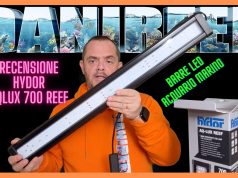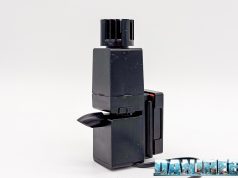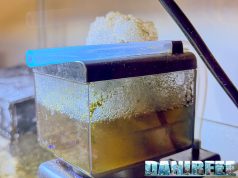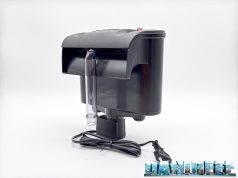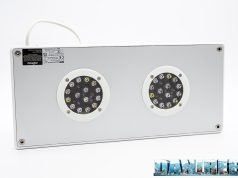The Magnet
The glass holding magnet can deal with thickness up to 15 mm.
The inner magnet has 4 blue rubber feet called Silent Blocks which absorb vibrations and limit the noise.
I always liked the Tunze system as it combines simple manufacture with wide range of pump orientation. It can be bulkier than other solutions but the pump remains very close to the tank walls.
The Noise
Tunze has a reputation for its noiseless pumps and it still didn’t disappoint our expectations.
We verified this by measuring environmental noise, with the tank and all its accessories working but the pump, and the phonometer at 1 meter distance from the pump.
We then measured the noise of the whole tank plus the Tunze Turbelle NanoStream 6045 pump working.
There is a very small 1,3 dB difference which we can ignore, the pump is almost noiseless.
To measure the noise I used, as always, the professional phonometer VOLTCRAFT 320, digital phonometer IEC 651 Type II which have been sufficiently accurate seeing the results. Considering the type of noise we needed to measure, all the measures were recorded with dBA wave attenuation. The measurements were taken with closed windows, the phonometer placed on a tripod 1 meter distant, and with minimum intervals of 120 seconds between measurements.
Power Consumption
It is quite hard to measure instant energy consumption. In order to do so, I used a current probe which recorded an electric current of 0,037 A. This is only a partial measure, as it has been impossible to record the power factor (cosφ). Anyway, we can still make some interesting deductions.
The adsorbed current, or the power consumption, results as follows:
Tunze Turbelle NanoStream 6045 with a flow rate of 4500 l/h: 0,037A x 226 V = 8,36 watt x cos(fi)
Usually, a pump with a neodymium magnet, like the 6045, has a cos(fi) with a value around 0,85, while a pump with a ferrite magnet has a cos(fi) around 0,6. In this case the energy consumption of the Tunze equals to 8,36 watt x 0,85 = 7,1 watt. A legitimate number, very close to the 7 watt declared. We should still consider that the cos(fi) was assumed, having not being able to measure it.
We want to underline that the apparent power of 1,26 watt in this case, 8,36-7,1 watt, is not counted by the home electrical counter, so we will not spend more. Moreover, this happens with any pump, Tunze is not an exception.
Considering an energy consumption of 7,1 watt, and the energy price in Italy of 0,27 euro per kwh, we could use this pump continuously for a whole year with a power consumption of 62 kwh, which will clearly be the same using a pair of 6045 alternately for 6 hours each, resulting in 16,8 euro per year, or 1,4 euro per month.
Once removed the external grid by applying a small pressure on the pumps sides, we find ourselves with pump’s core in our hand and we can remove the small impeller.
We can find a typical Tunze impeller with two blue flaps.
The flow comes out from a rather small opening if compared to current standards, the opening can also be regulated to reduce the flow rate. It still is a sufficient flow for a marine tank.
The pump doesn’t have a power supply but just a simple cable with a plug.















